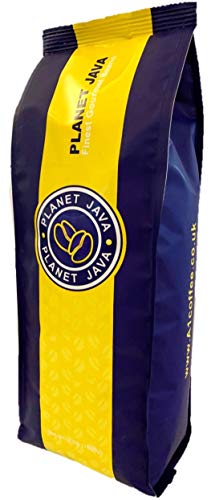Starbucks Coffee Beans 1kg
Before Peppermint Mocha and red holiday cups - Starbucks was just a cozy cafe in rainy Seattle. The founders of the company were focused on selling whole bean coffee, but they weren't aware of the potential of espresso drinks.
The situation changed when Schultz came on board. He was determined to showcase his roasting and blending techniques.

Origin
Starbucks coffee beans travel an extensive, winding route before they make it to your cup. Coffee is cultivated mainly in the Coffee Belt. This area stretches across the globe between the Tropics Cancer and Capricorn. The climate, soil, and culture of each region affect the flavor of the coffee beans. Starbucks sources its coffee beans from more than 30 countries.
Most Starbucks coffees are sourced from three major regions: Latin America, Africa, and Asia-Pacific. These regions are known for their full-bodied flavor, balance of acidity and weight. Starbucks also purchases coffee from St. Helena in the South Atlantic Ocean, a volcanic tropical paradise.
The Starbucks's coffee beans are and perfectly roasted and give them the perfect flavor and smooth texture. The coffee beans are ground into a fine powder, which is ready for brewing. The powder is then mixed with water and then poured into a cup to make an espresso drink that is delicious. The result is a cup that is full of flavor and energy.
Starbucks stores offer a range of single-origin beans. While the majority of Starbucks coffees come from blending different beans, they do have a few varieties that are made from just one bean. Single-origin Starbucks coffees are available in a variety of flavors including fruity and chocolatey, sweet and nuanced. Certain single-origin coffees are certified organic.
Starbucks's coffee is sourced from all over the globe however, they must meet certain requirements to be considered special. The term "specialty coffee" only came into use in the 1980s, when cafes and roasters started to experiment with lighter roasting, manual techniques, and transparent source. Starbucks did not begin using these standards until recently, but has since adopted these standards.
Starbucks also strives to improve the quality of life for those who grow its coffee. It pays its farmers a premium above market price and assists them in investing in their communities. It also promotes sustainability and strives to reduce waste. This has led to the development of new practices for coffee cultivation and techniques that help protect the environment.
Roast
1kg coffee beans price in large quantities and purchases the beans in bulk. The roasting process lasts between 10 and 15 minutes and the result is dark roasted beans. Dark roasted beans possess an intense flavor and have a full body. The beans are ground up and then delivered to supermarkets and stores in the form of a coffee grind. The coffee that is ground is bitter and is not the ideal choice for making the best cup. Many people add a lot of sugar or cream, flavorings and whipping cream to their coffee. This will not mask the bitterness in the coffee, but it can make the drink more appealing.
The beans begin to steam once they are placed in the roaster for the first time due to their internal moisture. Then comes the "first crack" which is a sound that tells us when the roasting process has actually begun. At this point, the sugars begin to caramelize and bound-up water escapes. During this time, the structure of the bean is broken down and the oil begin to flow outward. This stage is the time at which most coffees are considered a city roast.
The roasted beans are then removed from any stones or other impurities which may have escaped from the roaster. The beans are then inspected by hand and bagged to be sold. Some beans have a dark spot, which is known as a quaker. These beans didn't change color and taste burnt. This is a normal phenomenon, but it does not suggest that the coffee is bad.
The beans are usually roasted in small batches that can be as small as 20 pounds. These are called "micro-lots". This is because every coffee roast will be roasted in accordance with specifications set by the Starbucks team of masters of coffee. The team of coffee experts creates unique profiles that are used by all Starbucks(r) roasting facilities around the world. These profiles ensure that every cup of coffee made will be consistent, with certain levels of body and taste.
Flavor
Starbucks purchases their beans directly from the farm on which they were cultivated, to improve the quality of their beans and ensure an ethical source. For every kilogram of coffee beans sold, Starbucks plants a tree. The beans themselves are not identified by their origins to show the origins of the beans however some of the blends do - Veranda is from Sumatra, Komodo Dragon from Indonesian, and Anniversary is a mix of centeral american and african beans. The flavour profile of the beans is distinctive, and they create a smooth, velvety cup with delicate balance of sweetness and smoothness. Each sip offers a variety of flavours that leaves a pleasant taste on the palate.
Weight
The weight of starbucks coffee beans 1kg is contingent on the type of blend. A Starbucks House Blend, for instance, weighs 14 oz per pound. A pound of Espresso-roast beans at Walmart, however weighs 16 ounces. This is equivalent to a 67% cost premium at Starbucks in comparison to Wal-Mart.
Starbucks' Pike Place Roast is named for the iconic Seattle marketplace. Its medium-light roast gives balance, sweetness, and smoothness in every cup. This blend made of beans from Latin America is perfect for Americano or espresso. This blend is gourmet and comes with the FlavorLock package to protect the coffee and for preservation of flavor. This is Starbucks the classic signature coffee. It is a excellent choice for all coffee fans! Made from 100 percent Arabica beans. An ideal gift idea for all Starbucks customers.
